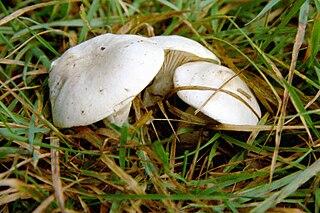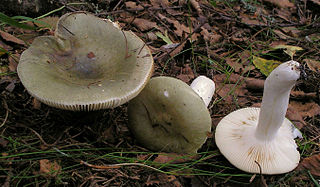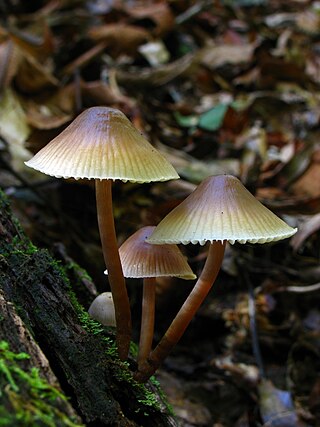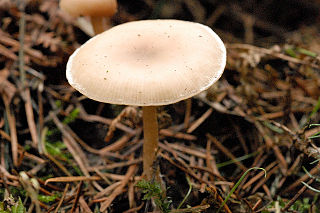
Clitocybe is a genus of mushrooms characterized by white, off-white, buff, cream, pink, or light-yellow spores, gills running down the stem, and pale white to brown or lilac coloration. They are primarily saprotrophic, decomposing forest ground litter. There are estimated to be around 300 species in the widespread genus.

Clitocybe odora, commonly known as the blue green anise mushroom, or aniseed toadstool, is a blue-green mushroom that grows near deciduous and coniferous trees. They can be found growing in small groups along the side of tree roots. This mushroom is edible, but a few expert mushroom hunters insist that young specimens should be avoided as they can be confused with Stropharia aeruginosa. The anise odor is due to the presence of p-anisaldehyde and a small amount of benzaldehyde. This odor can give away the mushroom's presence before it is observed by eye.

Clitocybe nuda, commonly known as the blewit or wood blewit and alternately described as Lepista nuda, is an edible mushroom native to Europe and North America. Described by Pierre Bulliard in 1790, it was also known as Tricholoma nudum for many years. It is found in both coniferous and deciduous woodlands. It is a fairly distinctive mushroom that is widely eaten. It has been cultivated in Britain, the Netherlands and France.

Lepista personata is a species of edible fungus commonly found growing in grassy areas across Europe and is morphologically related to the wood blewit.

Clitocybe dealbata, also known as the ivory funnel, is a small white funnel-shaped basidiomycete fungus widely found in lawns, meadows and other grassy areas in Europe and North America. Also known as the sweating mushroom, or sweat producing clitocybe, it derives these names from the symptoms of poisoning. It contains potentially deadly levels of muscarine.

Clitocybe nebularis or Lepista nebularis, commonly known as the clouded agaric, cloudy clitocybe, or cloud funnel, is an abundant gilled fungus which appears both in conifer-dominated forests and broad-leaved woodland in Europe and North America. Appearing in Britain from mid to late autumn, it is edible, but may cause gastrointestinal issues.

Clitocybe rivulosa, commonly known as the false champignon or fool's funnel, is a poisonous basidiomycete fungus of the large genus Clitocybe. One of several species similar in appearance, it is a small white funnel-shaped toadstool widely found in lawns, meadows and other grassy areas in Europe and North America. Also known as the sweating mushroom, it derives this name from the symptoms of poisoning. It contains potentially deadly levels of muscarine.

Clitopilus prunulus, commonly known as the miller or the sweetbread mushroom, is an edible pink-spored basidiomycete mushroom found in grasslands in Europe and North America. Growing solitary to gregarious in open areas of conifer/hardwood forests; common under Bishop pine along the coast north of San Francisco; fruiting shortly after the fall rains. It has a grey to white cap and decurrent gills.

Russula aeruginea, also known as the grass-green russula, the tacky green russula, or the green russula, is an edible Russula mushroom. Widely distributed in northern temperate regions, it is usually found under birch, mostly in pine forests. The very poisonous death cap can have a similar appearance, especially from above.

Ampulloclitocybe clavipes, commonly known as the club-foot or club-footed clitocybe, is a species of gilled mushroom from Europe and North America. The grey brown mushrooms have yellowish decurrent gills and a bulbous stalk, and are found in deciduous and conifer woodlands. Although considered edible, disulfiram-like reactions have been reported after consumption of alcohol after eating this mushroom.

Aspropaxillus giganteus, also Leucopaxillus giganteus, commonly known as the giant leucopax or the giant funnel, is a saprobic species of fungus in the order Agaricales. As its common names imply, the fruit body, or mushroom, can become quite large—the cap reaches diameters of up to 50 cm (20 in). It has a white or pale cream cap, and is funnel-shaped when mature, with the gills running down the length of the stem. Considered by some to be a choice edible when young, this species has a cosmopolitan distribution, and is typically found growing in groups or rings in grassy pastures, roadside hedges, or woodland clearings. It has been shown to contain a bioactive compound with antibiotic properties.

Mycena galericulata is a mushroom species commonly known as the common bonnet, the toque mycena, the common mycena or the rosy-gill fairy helmet. The type species of the genus Mycena was first described scientifically in 1772, but was not considered a Mycena until 1821. It is quite variable in color, size, and shape, which makes it somewhat difficult to reliably identify in the field. The mushrooms have caps with distinct radial grooves, particularly at the margin. The cap's color varies from grayish brown to dark brown and the shape ranges from bell-like to bluntly conical to flattened with an umbo. The stem is hollow, white, tough and thin, without a ring and often roots deeply into the wood on which it grows. The gills are white to grayish or even pinkish when mature and are connected by distinct cross-veins. The caps can reach 4 cm (1.6 in) in diameter, and have a mealy odor and taste. The spore print is white and the gills are pink at maturity, which can lead to possible confusion with species of the genus Pluteus. M. galericulata mushrooms grow mostly in clusters on the well-decayed stumps of deciduous and coniferous trees from spring to autumn. The species can generally be considered inedible. It is common and widespread in the entire temperate zone of the Northern Hemisphere, but it has also been reported from Africa.

Clitocybe vibecina is a common, inedible mushroom of the genus Clitocybe. It often grows in rings on needle litter, usually late in the year.

Cortinarius traganus, also known as the gassy webcap or lilac conifer cortinarius, is a basidiomycete mushroom of the genus Cortinarius. The mushrooms are characterized by their lilac color, the rusty-brown gills and spores, and rusty-brown flesh in the stem.

Cortinarius anomalus, also known as the variable webcap, is a basidiomycete fungus of the genus Cortinarius. It produces a medium-sized mushroom with a grayish-brown cap up to 5 cm (2 in) wide, gray-violet gills and a whitish stem with pale yellow belts below. The mushroom grows solitarily or in scattered groups on the ground in deciduous and coniferous forests. It is found throughout the temperate zone of the northern hemisphere.

Mycena maculata, commonly known as the reddish-spotted Mycena, is a species of fungus in the family Mycenaceae. The fruit bodies, or mushrooms, have conic to bell-shaped to convex caps that are initially dark brown but fade to brownish-gray when young, reaching diameters of up to 4 cm. They are typically wrinkled or somewhat grooved, and have reddish-brown spots in age, or after being cut or bruised. The whitish to pale gray gills also become spotted reddish-brown as they mature. The stem, up to 8 cm (3 in) long and covered with whitish hairs at its base, can also develop reddish stains. The mycelium of M. maculata has bioluminescent properties. The saprobic fungus is found in Europe and North America, where it grows in groups or clusters on the rotting wood of both hardwoods and conifers. The edibility of the fungus is unknown. Although the species is known for, and named after its propensity to stain reddish, occasionally these stains do not appear, making it virtually indistinguishable from M. galericulata.

Infundibulicybe geotropa, also known as the trooping funnel or monk's head, is a funnel-shaped toadstool widely found in Europe and in North America. A large sturdy cream- or buff-coloured funnel-shaped mushroom, it grows in mixed woodlands, often in troops or fairy rings, one of which is over half a mile wide. Although edible, it could be confused with some poisonous species of similar colouration and size.

Clitocybe albirhiza, commonly known as the snowmelt clitocybe, is a species of agaric fungus in the family Tricholomataceae. It is found in high-elevation locations in the western United States.

Paralepista flaccida is a species of mushroom found across the Northern Hemisphere. It is known to form fairy rings.

Infundibulicybe gibba, and commonly known as the common funnel or funnel cap, is a species of gilled mushroom which is common in European woods.




















